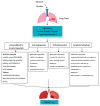Scutellaria baicalensis and Their Natural Flavone Compounds as Potential Medicinal Drugs for the Treatment of Nicotine-Induced Non-Small-Cell Lung Cancer and Asthma
- PMID: 34069141
- PMCID: PMC8155851
- DOI: 10.3390/ijerph18105243
Scutellaria baicalensis and Their Natural Flavone Compounds as Potential Medicinal Drugs for the Treatment of Nicotine-Induced Non-Small-Cell Lung Cancer and Asthma
Abstract
Flavonoids as the largest group of natural phytochemical compounds have received significant attention, as demonstrated by clinical trials, due to their chemotherapeutic and/or pharmacological effects against non-small-cell lung cancer (NSCLC) and asthma. Scutellaria baicalensis (S. baicalensis), known as one of the most popular medicinal plants and used in several countries, contains natural active flavone constituents, with the major compounds of the roots being baicalein, baicalin, wogonin, wogonoside and oroxylin A. S. baicalensis and their compounds are proven to have inhibitory effects on NSCLC cells when used at different concentrations. However, the exact mechanisms by which these compounds exert their therapeutic effects against asthma remain unexplored. Indeed, the mechanisms by which S. baicalensis and its flavone compounds exert a protective effect against nicotine-induced NSCLC and asthma are not yet fully understood. Therefore, this review explores the mechanisms involved in the therapeutic potential of flavone-rich extracts from S. baicalensis in nicotine-induced NSCLC and asthma.
Keywords: NSCLC; Scutellaria baicalensis; asthma; flavone compounds; nicotine.
Conflict of interest statement
The author declares no conflict of interest.
Figures
Similar articles
-
[Study advance in biosynthesis of flavone from Scutellaria].Zhongguo Zhong Yao Za Zhi. 2020 Oct;45(20):4819-4826. doi: 10.19540/j.cnki.cjcmm.20200709.601. Zhongguo Zhong Yao Za Zhi. 2020. PMID: 33350252 Review. Chinese.
-
The transcription factors SbMYB45 and SbMYB86.1 regulate flavone biosynthesis in Scutellaria baicalensis.Plant Physiol Biochem. 2023 Jul;200:107794. doi: 10.1016/j.plaphy.2023.107794. Epub 2023 May 24. Plant Physiol Biochem. 2023. PMID: 37257409
-
A specialized flavone biosynthetic pathway has evolved in the medicinal plant, Scutellaria baicalensis.Sci Adv. 2016 Apr 8;2(4):e1501780. doi: 10.1126/sciadv.1501780. eCollection 2016 Apr. Sci Adv. 2016. PMID: 27152350 Free PMC article.
-
Two CYP82D Enzymes Function as Flavone Hydroxylases in the Biosynthesis of Root-Specific 4'-Deoxyflavones in Scutellaria baicalensis.Mol Plant. 2018 Jan 8;11(1):135-148. doi: 10.1016/j.molp.2017.08.009. Epub 2017 Aug 24. Mol Plant. 2018. PMID: 28842248 Free PMC article.
-
Flavones from root of Scutellaria baicalensis Georgi: drugs of the future in neurodegeneration?CNS Neurol Disord Drug Targets. 2011 Mar;10(2):184-91. doi: 10.2174/187152711794480384. CNS Neurol Disord Drug Targets. 2011. PMID: 21222632 Review.
Cited by
-
VEGF and EGFR signaling pathways are involved in the baicalein attenuation of OVA-induced airway inflammation and airway remodeling in mice.Respir Res. 2024 Jan 4;25(1):10. doi: 10.1186/s12931-023-02637-6. Respir Res. 2024. PMID: 38178132 Free PMC article.
-
Antioxidant Intake and Biomarkers of Asthma in Relation to Smoking Status-A Review.Curr Issues Mol Biol. 2023 Jun 10;45(6):5099-5117. doi: 10.3390/cimb45060324. Curr Issues Mol Biol. 2023. PMID: 37367073 Free PMC article. Review.
-
Flavonoids in the Treatment of Non-small Cell Lung Cancer via Immunomodulation: Progress to Date.Mol Diagn Ther. 2025 May;29(3):307-327. doi: 10.1007/s40291-025-00772-y. Epub 2025 Mar 4. Mol Diagn Ther. 2025. PMID: 40036006 Review.
-
Baicalin promotes the sensitivity of NSCLC to cisplatin by regulating ferritinophagy and macrophage immunity through the KEAP1-NRF2/HO-1 pathway.Eur J Med Res. 2024 Jul 26;29(1):387. doi: 10.1186/s40001-024-01930-4. Eur J Med Res. 2024. PMID: 39061086 Free PMC article.
-
Promising leads against lung cancer from the plants in Lamiaceae family.Bioimpacts. 2024 Jun 8;15:30074. doi: 10.34172/bi.30074. eCollection 2025. Bioimpacts. 2024. PMID: 39963559 Free PMC article. Review.
References
-
- Institute for Health Metrics and Evaluation Global Burden of Disease. [(accessed on 2 February 2020)];2017 Available online: http://vizhub.healthdata.org/gbd-compare/#.
Publication types
MeSH terms
Substances
LinkOut - more resources
Full Text Sources
Medical


